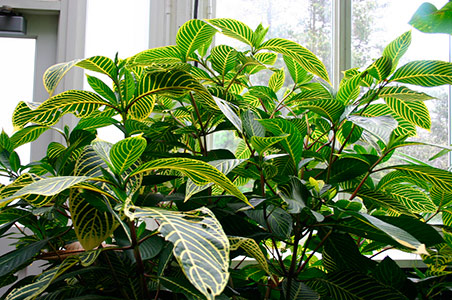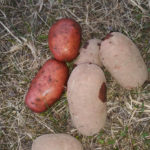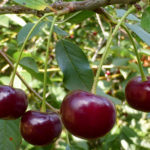Sanchezia: care, reproduction, use in landscaping interiors
Among the large-leaved indoor crops, the sanchetia are distinguished not only by their rather large size and volume, but also by their surprisingly noble appearance. Proud, with bright, and sometimes variegated leaves, with very rare elegant inflorescences, they flaunt a lush structure of a branched bush. Sanchezia are floor crops with universal application in interior design.

Decorative virtues of the sanchetia
Of the more than 60 natural types of Sanchezia in room culture, only Ecuadorian Sanchezia is mainly used, a very fast growing and easy to thicken. In indoor culture, it is much more compact than more than two-meter "wild" relatives. The growth rates of the sanchetia make it possible to obtain a large outdoor decoration even from the smallest seedling in a few years. Sanchetia develops specifically, requiring constant pruning: only young shoots with numerous leaves look attractive in the plant, while after the first winter without rejuvenation, the branches lose their foliage and stretch out. During this period, the sanchetia is drastically cut off, and it quickly recovers in the spring.
The main pride of the Sanchetia is the large leaves sitting on small petioles with bright golden-yellow stripes along the rib-like veins. The leaves are almost 10 cm wide and more than 30 cm long.
The bloom of the Sanchetia is also quite attractive. Flowers with massive bracts are asymmetric, form a loose arrow-shaped spikelet at the top of the shoots, however, only those who decide to sacrifice the decorativeness of the leaves will be able to enjoy the flowering of the sanchetia: this culture blooms only on last year's shoots, which stretch out and practically lose leaves during the winter, spoil the attractiveness of the whole plant. If you still do not want to completely abandon flowering, leave only one or two shoots, shortening the rest and allowing them to form crowns under the bare peduncles.
Sanchezia in landscaping interiors
Sanchezia belong to the most beautiful cultures for the decoration of the "lower" level. They are placed on the floor, or at least below the level of vision, so that they are always viewed from top to bottom. Sanchezia create the effect of fullness of greenery, naturalness and freshness in the room. They can be placed both along the perimeter of one of the walls by the window, masking its lower edge and baseboard, and in the corners, fully compensating for the intersection of rough lines and visually rounding their contours. If sanchezia are placed along the wall, it is imperative to hide its dimensions, level the effect of the beginning or end of the line, if necessary, combine a number of sanchezia with other floor accessories.
They visually slightly narrow the space and raise the level of the ceiling, but at the same time they are one of the best tools for creating a calm atmosphere of peace and detachment from the outside world. You can use sanchezia in almost any room in the house, but preference should be given to medium and large rooms and avoid small offices and limited functional areas.
Sanchezia care at home
The intensity of the color of the leaves and the compactness, the density of the foliage of the sanchetia are preserved only in diffused bright light, which is why they are more often used as an outdoor plant near the windows. In partial shade or shade, the shoots of plants are too stretched, so the place for growing is selected very carefully.
Sanchezia are quite comfortable to grow in the usual home temperature range.
They need to be provided with a pot with a large drainage hole, a nutritious loose substrate and a thick layer of coarse drainage. When transplanting, it is extremely important not to damage the earthen ball and rhizome, carrying out a quick transfer. It is strictly forbidden to deepen the sanchezia in comparison with the soil level in the previous container. Since the plants grow very quickly, they are transferred into a large container annually, and with active filling of the soil with roots, and more often, carrying out an additional transplant in the midst of a period of active growth.
In winter, sankhezia require only the usual reduction in irrigation without changing the air temperature and light intensity.
It is very easy to propagate sanchezia by rooting shoots cut in spring in sand or sandy soil mixture.
The main component of caring for sanchezia is constant pinching of the shoots to increase their thickening and regular pre-spring pruning, which, thanks to the low cut of the shoots, make it possible to rejuvenate the sanchetia. The main task is to create dense branching and maintain a constant decorative effect. If the sanchezia drives out long branches and lashes during the season, which, in the end, will lose all the leaves, it is better to shorten them in time. Pruning is carried out in February or early March, while before the start of active growth, sanchezia do not look very attractive and they can be rearranged in places with similar growing conditions, where they will be less conspicuous.
Sanchezia needs frequent and abundant watering without allowing even a single drying out of the earthy coma, which will inevitably lead to the shedding of leaves. But waterlogging, stagnation of moisture are also unacceptable: after each procedure, it is necessary to drain the water from the pallet. During the warm season, the sanchezia are fed weekly or at least once every two weeks, alternating mineral and organic fertilizers. The sankhetsii are fed only after abundant watering with clean water (as a procedure for additional, repeated watering).
In winter, to compensate for the operation of heating devices, it is often necessary to spray the leaves of plants using warm boiled water (even ordinary settled water can leave unattractive traces).








